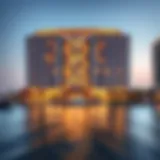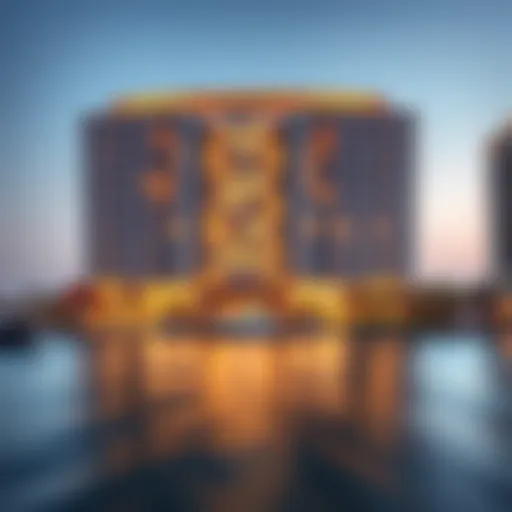Dubai Metro Lines: Exploring Urban Mobility and Growth
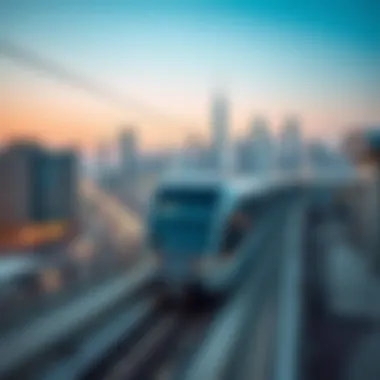

Intro
The Dubai Metro has become not just a mode of transport, but a lifeline for both residents and visitors of this bustling city. Since its inauguration in 2009, the system has evolved rapidly, reshaping how people navigate Dubai. It serves as a powerhouse of urban mobility, fostering connectivity while becoming a beacon for real estate development. This exploration aims to shed light on the intricate details of the various metro lines, their historical backdrop, operational specifics, and more importantly, their influence on real estate dynamics within the city.
The metro lines form a crucial part of the urban fabric, forming arteries that pulse with activity. This article will delve into the unique attributes of each of its lines, offering a panoramic view of how they link different districts while simultaneously transforming the local real estate market. By examining current market trends and opportunity hotspots, this discussion will equip real estate agents, investors, homebuyers, advisors, and developers with valuable insights that can aid in smart decision-making.
As we navigate through the details of the metro lines, we will also touch upon how economic factors influence property values in neighborhoods adjacent to these transit lines, making it a compass for understanding market shifts. This comprehensive overview will focus not only on the operational aspects of the metro system but also on its profound significance within the urban planning landscape of Dubai.
Prelude to Dubai Metro
The introduction of metro systems into urban landscapes has become a hallmark of modern city planning. In Dubai, the Metro is not just a transport tool; it is a symbol of innovation and forward-thinking that resonates throughout the bustling city. This section introduces the Dubai Metro and underscores its vital role in shaping not only the public transit system but also the urban framework of the city. With the initial aim of alleviating traffic woes, today, the Metro stands as a paragon of efficiency, connecting key areas while reflecting the city's rapid development.
Overview of Urban Transportation
Urban transportation is the lifeblood of any metropolitan area. In cities like Dubai, where rapid growth often accompanies explosive population increases, having a robust transportation system is an absolute necessity. The Metro complements other forms of transport including buses, taxis, and water taxis. Furthermore, it achieves multiple objectives:
- Efficiency: Cuts down travel time significantly compared to road transport.
- Accessibility: Connects outlying neighborhoods with commercial and entertainment hubs.
- Sustainability: Reduces vehicular emissions and promotes eco-friendly transit.
In contrast to other urban transport systems, the Dubai Metro operates with a significant level of efficiency, featuring automated systems and modern trains that traverse a vast landscape. While there’s a tangible air of luxury that surrounds Dubai, the focus on practical urban needs remains at the forefront, ensuring that all demographics can benefit from this system. The Metro also serves tourists, providing them a seamless way to navigate the city without the hassle of driving in hectic traffic.
The Evolution of Metro Systems
The concept of metro systems has evolved significantly since their inception in the late 19th century. Initially, these systems were simple railways designed to address urban congestion. However, as urban populations soared, so did the complexity and sophistication of metro designs.
Today, metro systems showcase advanced technology including:
- Real-time data systems: Passengers can track train schedules via smartphones for better planning.
- Automated operations: Many modern metros are driverless, enhancing safety and operational efficiency.
- Integrated ticketing systems: Allow passengers to use a single ticket across various transport types, enhancing user experience.
The Dubai Metro, opened in 2009, is a testament to this evolution. It stands out due to its state-of-the-art infrastructure and strategic planning aimed at foresighted growth. By creating a network that adjusts to the city's needs, the Metro has dramatically reshaped the landscape—literally and figuratively. With ongoing advancements in technology and operations, this transportation marvel continues to evolve to meet the demands of a growing urban environment.
"Urban transportation is not only about moving people but also about connecting lives and creating opportunities."
The importance of the Dubai Metro cannot be overstated. It reflects a commitment to innovative infrastructure and sustainable urban planning. Understanding its background and current state provides valuable insight into why it serves as a cornerstone of Dubai’s urban fabric.
Metro Lines: An Overview
The metro lines in Dubai form the backbone of public transport in the city, playing a pivotal role in enhancing urban mobility and connectivity. This section unpacks the significance of these lines, focusing on their characteristics, benefits, and the considerations surrounding them. The two primary lines, the Red and Green lines, not only facilitate movement but also substantially influence real estate development and urban planning. The growth of the metro network has been driven by the pressing need for efficient transportation solutions as the city continues to expand and evolve.
Red Line
Route Description
The Red Line of the Dubai Metro stretches approximately 52 kilometers, linking key areas from Rashidiya to UAE Exchange. This line is notable for its efficiency, operating as a rapid transit system that serves both residents and tourists alike. The line runs mostly above ground, providing riders with panoramic views of the city’s striking skyline. Furthermore, the Red Line’s accessibility to major landmarks, such as the Dubai Mall and Burj Khalifa, makes it a preferred transit option for many. Its unique integration of technology ensures smooth operations and high-frequency service, creating a beneficial experience for riders.
Key Stations
The key stations on the Red Line are strategically located to cater to the economic and social demands of the city. Key stops include Burj Khalifa/Dubai Mall, Union Square, and Dubai Marina, each serving as bustling hubs of activity. Union Square acts as the interchange with the Green Line, enhancing connectivity. The unique feature of these stations lies in their design, each reflecting the architectural style of their surroundings, which adds to the cultural experience of passengers. Their positioning significantly enhances foot traffic in adjacent commercial areas, promoting economic viability.
Impact on Real Estate
The Red Line has helped boost property values along its route. Real estate in proximity to the stations has seen surges in demand due to the ease of access offered by the metro. Residential developments near the Burj Khalifa, for instance, have thrived since the line's inception. This accessibility has transformed previously neglected areas into vibrant communities. As a result, investors and developers are keen to explore opportunities around key stations, understanding the unique advantage that metro access brings to their properties.
Green Line


Route Description
The Green Line spans 22.5 kilometers and offers an essential route from Etisalat to Dubai Creek. Unlike the Red Line, a substantial portion of the Green Line runs underground, providing a contrasting experience for passengers. Characterized by its connectivity to various commercial districts and residential neighborhoods, the line reflects the diverse urban fabric of Dubai. The route description underscores how this line plays a critical role in linking new developments with existing infrastructure, fostering greater cohesion within the city’s transit landscape.
Key Stations
Key stations on the Green Line, such as Al Gubaiba and Dubai Healthcare City, serve specific demographics effectively. These stations are designed with distinct features that cater to the needs of workers and residents, particularly in bustling sectors like healthcare and transport. Each stop is equipped with amenities aimed at enhancing convenience for passengers, ensuring that their transit experience is seamless. The emphasis on accessibility makes the stations a advantageous aspect in driving foot traffic and nurturing local businesses.
Impact on Real Estate
The Green Line's influence on real estate is equally impressive, with property developments witnessing significant value increases in response to the metro's presence. Areas like Dubai Healthcare City have seen an influx of residential and commercial projects due to improved access afforded by the Green Line. This growth showcases how urban infrastructure investments can effectively spur real estate market dynamics, indicating a trend towards integrated urban living that buyers and investors are increasingly interested in.
Future Metro Lines
Proposed Extensions
Looking ahead, Dubai is contemplating several proposed extensions to its metro network. Plans include extending the Red Line towards the Dubai World Central, which aims to facilitate access to the Expo 2020 site and beyond. This expansion is characterized by its potential to interlink various transit systems, enhancing connectivity across the region. The unique feature of these proposed extensions is their foresight in accommodating future population growth and urban development trends, ensuring that the metro continues to meet demands in a prosperous city.
Projected Impact on Urban Development
The projected impact on urban development from these extensions is significant. By integrating new neighborhoods into the metro network, city planners anticipate an upturn in socio-economic activity and residential proliferation. Improved connectivity can catalyze new investment opportunities, altering land-use patterns and encouraging sustainable urban growth. Thus, these future extensions position themselves as crucial components in shaping Dubai's urban landscape for the years to come.
Construction and Technology
When discussing the infrastructure that supports a city as dynamic as Dubai, Construction and Technology emerges as a pivotal topic. The Dubai Metro system isn’t just about railways and trains; it embodies the marriage of advanced construction methods and cutting-edge technology, shaping the urban landscape in ways that are profound and lasting.
Engineering Challenges
Building a metro system in an arid desert environment like Dubai is no walk in the park. Engineers faced a myriad of challenges, from geological hurdles to the necessity of integrating the network into an already bustling cityscape. One major issue was the soft and unstable soil conditions, requiring extensive geotechnical surveys and tailored foundation designs. For instance, in areas like Business Bay, where the water table is high, specialized underground methods had to be employed to stably construct tunnels.
Moreover, the sheer scale of the project meant coordinating numerous stakeholders, from government bodies to private contractors, each with their own timelines and goals. Such a vast operation often led to logistical headaches. But thanks to meticulous planning and robust engineering strategies, including the use of 3D modeling technologies and sophisticated project management software, these challenges were anticipated and systematically addressed.
Innovative Building Techniques
The construction of the Dubai Metro is a testament to innovation. Traditional methods were often cast aside in favor of techniques that maximize efficiency and safety. A significant advancement was the adoption of the top-down construction method, which allowed for faster tunnel excavation while minimizing disruption above ground.
In addition, the use of pre-cast concrete segments revolutionized the construction timeline. Instead of pouring concrete on-site and waiting for it to cure, segments were fabricated in controlled environments, then transported and assembled on-site. This not only sped up the process but also enhanced the quality and consistency of the components. Such innovation reflects broader trends in construction, pushing the boundaries of what’s possible in urban infrastructure development.
Sustainability Features
Sustainability has been a buzzword in urban planning, and the Dubai Metro does not miss the mark here. It features a range of sustainability features aimed at reducing its carbon footprint and promoting eco-friendly transportation. One of the most significant aspects is the use of energy-efficient systems. The trains are equipped with regenerative braking technology, allowing them to convert kinetic energy back into electricity, reducing overall energy usage.
Furthermore, the stations themselves are designed with sustainability in mind. With solar panels and green roofing, they contribute to energy generation and management. Water conservation measures are also implemented, enhancing the overall ecological profile of the metro system. The investment in these sustainable practices illuminates the commitment Dubai has made not just to urban mobility, but to being a leader in global sustainability efforts.
"The Dubai Metro serves not only as a vital transit system but also as a beacon of modern engineering and eco-conscious design, setting the standard for future urban transport systems globally."
Given the challenges faced, the innovative approaches taken, and the emphasis on sustainability, the construction and technology behind the Dubai Metro serves as a model for urban transit development worldwide, making it a focal point of interest for real estate professionals and urban planners alike.
Socio-Economic Impact
The socio-economic impact of the Dubai Metro is palpable across various sectors, enhancing the city's urban fabric and facilitating economic growth. This electric train network does more than just transport people; it acts as a catalyst for local businesses, a moderator of traffic woes, and a driver of urban mobility.
Boosting Local Economies
The role of the Dubai Metro in bolstering local economies cannot be overstated. By connecting residential areas with commercial hubs, the metro enables easier access for both workers and shoppers. For example, areas like Deira and Bur Dubai have blossomed, witnessing a surge in foot traffic thanks to their proximity to metro stations. Businesses ranging from small retail shops to large dining establishments benefit from this spike in visitors.
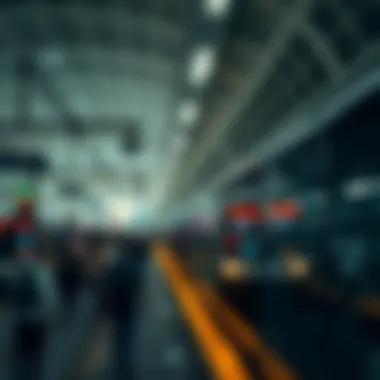

"Where there’s movement, there’s money to be made."
In addition, the metro encourages people to explore neighborhoods they might not have visited otherwise, leading to a more vibrant local economy. This increased accessibility has also made way for innovative startups and services that cater to metro commuters. Small businesses in the vicinity of metro stations have reported a marked increase in sales, creating jobs and stimulating investment.
Reduction of Traffic Congestion
It’s no secret that traffic congestion has been a persistent issue in Dubai. The advent of the metro has taken a substantial bite out of the number of cars on the road. By providing a reliable alternative to personal vehicles, the Dubai Metro helps alleviate pressure on the road networks. In peak hours, trains run regularly, preventing bottlenecks and long waits.
The stats are telling: studies indicate that traffic congestion in areas surrounding metro stations has decreased by nearly 30%. More commuters opting for the train means fewer cars on the highway, leading to reduced travel times and a significant drop in air pollution levels.
Enhancement of Urban Mobility
Urban mobility is a crucial component for any metropolitan area, and the Dubai Metro stands as a testament to this. With trains running every few minutes and covering a vast area, the system enhances overall mobility within the city.
For residents, this translates to more time spent enjoying life and less time caught in traffic jams. The interconnectivity with various bus routes adds layers to the mobility experience, allowing seamless transitions between different modes of transportation.
Moreover, as the city evolves, there’s a pressing need for sustainable urban solutions. The metro system embodies that ethos by facilitating eco-friendly travel. Its impact is not only about physical movement; it represents a shift towards an integrated urban landscape where accessibility aligns with sustainability.
In summary, the socio-economic ramifications of the Dubai Metro stretch beyond mere transportation. It’s a fundamental element that influences local economies, mitigates traffic troubles, and redrafts how urban mobility is perceived. Its proliferation is essential for future urban planning efforts in a city that's growing at breakneck speed.
For more insights on urban transportation systems, visit Wikipedia or check out resources from local government websites on city infrastructure plans.
Impact on Real Estate Development
The intersection of transit systems and real estate is a crucial focal point for understanding urban growth and property dynamics. The Dubai Metro, a cornerstone of the city’s infrastructure, has not only enhanced mobility but also fervently influenced the real estate landscape. As cities expand and adapt to their populations, the role of metro systems like Dubai's becomes increasingly salient. The lines shape accessibility, desirability, and ultimately, property values.
To grasp the implications of the Dubai Metro on real estate, several key elements emerge:
- Accessibility: Properties located near metro stations enjoy a significant advantage in terms of accessibility. Easy transport options can lead to increased demand for residential and commercial spaces nearby.
- Urban Development: As the metro expands, it catalyzes urban development by encouraging new projects aimed at housing, retail, and corporate offices. The surrounding areas witness a surge in growth, transforming once-quiet streets into bustling hubs.
- Investment Returns: Investors are invariably drawn to properties in close proximity to metro stations, anticipating a higher return on their investment due to rising demand and property value appreciation.
Moreover, proximity to the metro often correlates with improved amenities and quality of life, appealing to homebuyers and renters alike.
Property Values Near Metro Stations
In the real estate market, location is king, and metro stations serve as pivotal landmarks in this regard. Studies have shown that properties situated close to metro stations tend to command higher prices than those further away. For instance, according to research from the Urban Land Institute, properties within a half-mile radius of a metro station see an average price increase of approximately 15-25% compared to those located a mile or more away.
This phenomenon is attributed to several factors:
- Convenience: Homebuyers value the ease of commuting. Access to reliable and efficient transportation can significantly enhance the appeal of properties, making them more marketable.
- Security Increases: Areas around metro stations often receive enhanced safety measures, which can bolster consumer confidence in the neighborhood.
- Improved Infrastructure: Development often follows transport links, meaning that essential services and recreational options tend to flourish in these areas, adding to the allure.
However, it’s important to note that not all properties gain equally. Characteristics like local amenities, neighborhood reputation, and specific metro lines’ traffic patterns play a considerable role in determining property values.
Trends in New Developments
The advent and expansion of the Dubai Metro has sparked a notable shift in the types of developments emerging across the city. Developers increasingly tailor projects to capitalize on metro accessibility, leading to several discernible trends:
- Mixed-Use Developments: There is a growing inclination towards mixed-use projects that blend residential, commercial, and recreational facilities. These types of developments thrive around metro stations, reflecting a lifestyle where residents can live, work, and socialize within a compact radius.
- Sustainable Design: A trend in sustainability is also notable. Developers are now more inclined to integrate eco-friendly building practices and design. The metro’s commitment to sustainability encourages these practices, as residents often look for environmentally-conscious options.
- Luxury Living: High-end projects are on the rise near major metro lines, appealing to a demographic that desires convenience alongside luxury. Many new developments include high-end amenities, such as rooftop gardens and fitness centers, tapping into the city's affluent market.
These developments not only cater to a range of demographics but also signal a commitment to urban planning that values connectivity, sustainability, and community engagement.
Overall, it’s plain to see that the Dubai Metro is a game-changer in the real estate sector. The interplay of accessibility, urban development, and economic shifts driven by the metro lines creates a fertile ground for property growth, further shaping Dubai's diverse and dynamic real estate landscape.
Regulatory Framework
The regulatory framework surrounding the Dubai Metro is vital for ensuring that this extensive transit system operates smoothly, efficiently, and safely. In a city where urban growth is rapid and infrastructural demands are continuously evolving, having a robust framework in place helps facilitate expansion and maintenance while adhering to global standards. This framework impacts not only the transportation sector but also the economic viability of real estate projects associated with the metro lines and the city's overall urban planning initiatives.
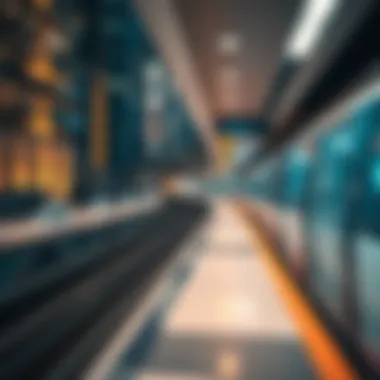

Permit and Approval Processes
The permit and approval processes form a fundamental part of the regulatory framework. Each construction phase of the Dubai Metro, from planning to execution, requires a series of approvals from various governmental bodies. These bodies, such as the Roads and Transport Authority (RTA) and the Dubai Municipality, ensure not only compliance with safety standards but also that the project aligns with the overall vision of urban development outlined in the city's strategic plans.
The complexity of these processes can be overwhelming, yet they serve critical purposes:
- Public Safety: Ensuring that all structures and systems are built to withstand the unique challenges posed by Dubai's environment.
- Environmental Consideration: Emphasizing the need for sustainability, so projects account for ecological impacts.
- Community Engagement: Involving local communities in the planning phase can help address any concerns and adapt plans based on public input.
Obtaining the required permits often necessitates detailed documentation and project proposal presentations. This can lead to delays, so understanding the timelines associated with each approval stage helps investors and developers plan their projects accordingly.
The Role of Government Policies
Government policies play a significant role in shaping the landscape of transport infrastructure in Dubai, particularly concerning the Metro. These policies not only articulate the objectives related to urban mobility but also integrate issues of safety, sustainability, and connectivity. They aim to reduce carbon footprints while enhancing accessibility for residents and visitors alike.
A few key aspects are noteworthy:
- Strategic Initiative: Policies often align with Dubai's broader vision for 2040, emphasizing sustainable urban growth and defining the integration of public transport into daily life.
- Financial Incentives: The government may provide financial incentives for projects that align with sustainability goals or contribute to community development.
- International Standards: Policies implemented often reflect adherence to international best practices, ensuring that the Dubai Metro not only meets local needs but also positions the city as a global leader in urban transportation.
Understanding this interplay between transport regulations and government policies is crucial for real estate agents and investors. It offers insight into the nuances of developing properties in proximity to metro lines, as these factors will undoubtedly affect property values and future neighborhood developments.
"A well-regulated transit system is integral to enhancing urban living, driving economic growth while fostering a culture of mobility across the city."
By examining both the permit processes and the overarching government policies, stakeholders can navigate the complexities of real estate developments linked to the Dubai Metro, ensuring informed decisions that align with long-term urban development strategies.
Future Prospects
The future of the Dubai Metro system is not just about expanding the lines; it reflects the broader vision for urban development in Dubai. With the city continually evolving, the metro's expansion plans and strategic approaches are pivotal for enhancing the connectivity and functionality of urban areas. These prospects not only aim to improve the transportation framework but also indirectly uplift the local economy and real estate market.
Projected Expansion Plans
Dubai's metro network is set to undergo significant growth, with plans in place to introduce new lines and extend existing routes. This expansion aims to cater to the increasing population and the influx of tourists. For instance, the Purple Line, designed to connect with key districts, is a notable future addition. This line will likely enhance connectivity between densely populated areas and commercial hubs, turning once more isolated neighborhoods into thriving centers of activity.
A few projected expansions include:
- Additional Stations: New stations will be added to connect emerging neighborhoods like Dubai South and other developing residential areas.
- Increased Frequency: With the completion of these expansions, the hopes are for more frequent service, thereby reducing waiting times for commuters.
- Smart Integration: Upgrades in technology are on the horizon, including smart ticketing systems and real-time transit updates, improving the rider experience.
Such expansions are not only about adding physical structures. They also bring about economic opportunities, as new commerce and residential projects sprout up around metro stations, making property near these hubs increasingly desirable.
Long-Term Urban Development Strategies
The implications of the metro's expansion go beyond transportation. They are entwined with strategic urban development initiatives aimed at creating a sustainable and livable environment in Dubai. By aligning the metro's growth with urban planning, city officials aim to create a well-connected urban landscape that encourages public transit use over personal vehicles. Here are several strategies at play:
- Mixed-Use Developments: Urban planners are focusing on mixed-use developments near metro stations, promoting a lifestyle where residents can live, work, and play within walking distance of transit. This encourages less reliance on cars and supports sustainable growth.
- Green Spaces: There’s a push to integrate green spaces in urban plans surrounding metro stations. Parks and community spaces can help foster a sense of community and improve the overall quality of life.
- Public-Private Partnerships: To finance ambitious projects, Dubai is leveraging partnerships with private investors to fund expansion. This approach helps mitigate financial risks while promoting innovation in the way urban space is developed.
"The success of the metro is intertwined with how effectively the urban landscape adapts and evolves alongside it."
Through careful planning and foresight, the Dubai Metro is set to anchor an interconnected city where efficient transportation underpins robust economic activity. This not only caters to current audiences but also prepares the city for future challenges in urban living, ensuring that Dubai remains a vibrant metropolis at the heart of innovation.
The End
The mega urban landscape of Dubai is significantly defined by its efficient Metro system. As we've explored the various lines and their impacts on the realm of real estate, the importance of this connectivity can't be overstated. Not only is the Metro a means of transportation, but it also serves as a catalyst for urban development and a structure that molds the socio-economic fabric of the city.
Summary of Key Points
In this article, we journeyed through numerous facets of the Dubai Metro, delving into essential aspects such as:
- Metro Lines Overview: We discussed the key lines like the Red and Green lines, noting their unique routes and significant stations that play a major role in facilitating urban mobility.
- Construction and Technology: We examined the engineering challenges encountered during construction, innovative techniques employed, and sustainability features that align with global environmental concerns.
- Socio-Economic Impact: The Metro has a substantial influence on local economies, significantly reducing traffic congestion, and improving urban mobility across the city.
- Real Estate Development: As we’ve established, proximity to Metro stations correlates with rising property values, fostering new developments in neighborhoods, reshaping the real estate market, and enhancing overall urban planning.
- Regulatory Framework: Without a solid regulatory framework, the expansion and efficiency of the Metro system would lack direction. The government policies in Dubai have been crucial in this regard.
- Future Prospects: We have also speculated on projected expansion plans that promise to further revolutionize the urban landscape of Dubai, capitalizing on existing networks while catering to future growth.
The Dubai Metro isn't just about getting from point A to point B; it's about transforming lives, communities, and the overall landscape of urban living.
With this comprehensive understanding, readers—whether they be real estate agents, investors, homebuyers, advisors, or developers—can appreciate not only how the Metro shapes neighborhoods, but also how significant it is to strategic investment potential in Dubai. Engaging with this topic leads us to acknowledge that as the Metro expands and evolves, so too does the opportunity for integrated living spaces that embody the future of urban mobility.
